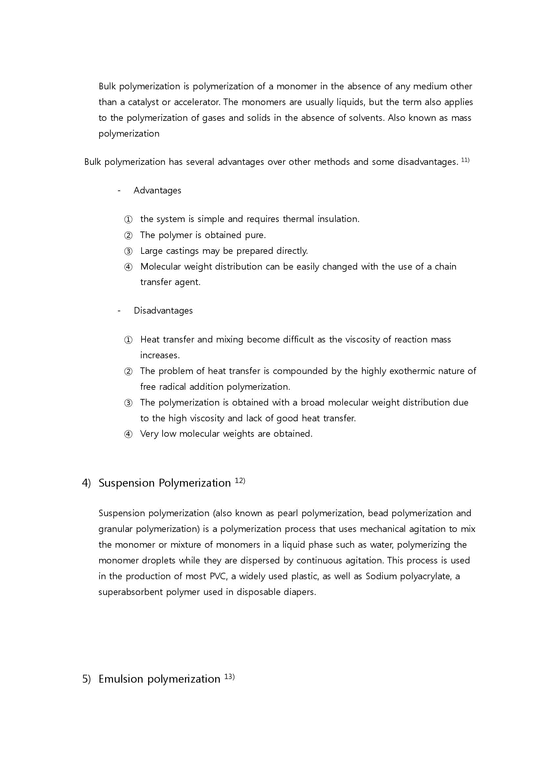[화학공학] PVAc와 PVA 합성
 등록일 / 수정일
등록일 / 수정일 페이지 / 형식
페이지 / 형식 자료평가
자료평가 구매가격
구매가격
- 2013.03.20 / 2019.12.24
- 15페이지 /
 docx (MS워드 2007이상)
docx (MS워드 2007이상) - 평가한 분이 없습니다. (구매금액의 3%지급)
- 1,700원
최대 20페이지까지 미리보기 서비스를 제공합니다.
자료평가하면 구매금액의 3%지급!
 1
1 2
2 3
3 4
4 5
5 6
6 7
7 8
8 9
9 10
10 11
11 12
12 13
13 14
14 15
15
추천 연관자료
- 목차
-
1. Objective
2. Theory
3. Apparatus
4. Reagents
5. Procedure
6. Results
7. Discussion
- 본문내용
-
1. Objective 1)
PVA(poly(vinyl alcohol)) is prepared by hydrolysis of PVAc(poly(vinyl acetate)), which is synthesized by emulsion polymerization of vinyl acetate.
2. Theory
1) Monomer 7)
A monomer is an atom or a small molecule that may bind chemically to other monomers to form a polymer. The term "monomeric protein" may also be used to describe one of the proteins making up a multiprotein complex. The most common natural monomer is glucose, which is linked by glycosidic bonds into polymers such as cellulose and starch, and is over 76% of the weight of all plant matter. Most often the term monomer refers to the organic molecules which form synthetic polymers, such as, for example, vinyl chloride, which is used to produce the polymer polyvinyl chloride (PVC).
2) Polymer 8)
A polymer is a large molecule (macromolecule) composed of repeating structural units. These subunits are typically connected by covalent chemical bonds. Although the term polymer is sometimes taken to refer to plastics, it actually encompasses a large class of natural and synthetic materials with a wide variety of properties.
Because of the extraordinary range of properties of polymeric materials, they play an essential and ubiquitous role in everyday life. This role ranges from familiar synthetic plastics and elastomers to natural biopolymers such as nucleic acids and proteins that are essential for life.
Most commonly, the continuously linked backbone of a polymer used for the preparation of plastics consists mainly of carbon atoms. A simple example is polyethylene, whose repeating unit is based on ethylene monomer. However, other structures do exist; for example, elements such as silicon form familiar materials such as silicones, examples being silly putty and waterproof plumbing sealant. Oxygen is also commonly present in polymer backbones, such as those of polyethylene glycol, polysaccharides (in glycosidic bonds), and DNA (in phosphodiester bonds).
Polymer properties are broadly divided into several classes based on the scale at which the property is defined as well as upon its physical basis. The most basic property of a polymer is the identity of its constituent monomers. A second set of properties, known as microstructure, essentially describe the arrangement of these monomers within the polymer at the scale of a single chain. These basic structural properties play a major role in determining bulk physical properties of the polymer, which describe how the polymer behaves as a continuous macroscopic material. Chemical properties, at the nano-scale, describe how the chains interact through various physical forces. At the macro-scale, they describe how the bulk polymer interacts with other chemicals and solvents.
- 참고문헌
-
1) Chemical Engineering Laboratory 1, Sungkyunkwan Univ. Chemical Engineering, 2011
2) http://atelierace.egloos.com/2442963
3) http://en.wikipedia.org/wiki/Potassium_persulfate
4) http://en.wikipedia.org/wiki/Sodium_lauryl_sulfate
5) http://en.wikipedia.org/wiki/Vinyl_acetate
6) http://en.wikipedia.org/wiki/H2o
7) http://en.wikipedia.org/wiki/Monomer
8) http://en.wikipedia.org/wiki/Polymer
9) http://people.clarkson.edu/~sminko/nanostructured/responsive-smart-materials/stimuli-responsive-nanostructures.html
10) http://composite.about.com/library/glossary/b/bldef-b836.htm
11) http://en.wikipedia.org/wiki/Bulk_polymerization
12) http://en.wikipedia.org/wiki/Suspension_polymerization
13) http://www.absoluteastronomy.com/topics/Emulsion_polymerization
14) http://www.absoluteastronomy.com/topics/Radical_polymerization
15) http://www.absoluteastronomy.com/topics/Emulsion
16) http://www.absoluteastronomy.com/topics/Surfactant
17) http://en.wikipedia.org/wiki/Solution_polymerization
18) www.nitto.com/rd/base/adhesive/c...ite.html
19) http://en.wikipedia.org/wiki/Polyvinyl_acetate
20) http://en.wikipedia.org/wiki/Polyvinyl_alcohol
21) http://en.wikipedia.org/wiki/Latex
22) http://www.scienceall.com/dictionary/dictionary.sca?todo=scienceTermsView&classid=&articleid=250388&bbsid=619&popissue=
자료평가
-
아직 평가한 내용이 없습니다.










